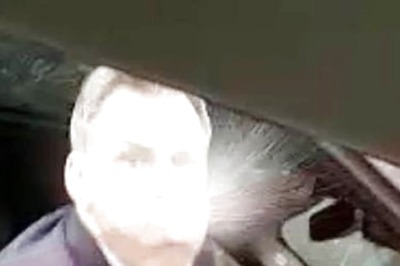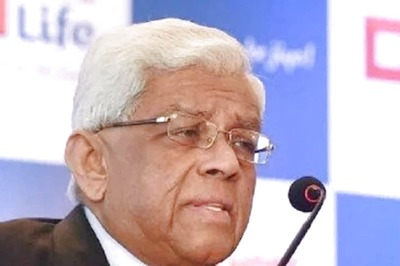
views
Washington: The US unemployment rate tumbled to a 2-1/2 year low in November, even though the pace of hiring remained too slow to suggest a significant acceleration in the labor market recovery.
Nonfarm payrolls increased by 120,000 jobs, the Labor Department said on Friday, and the jobless rate dropped to 8.6 per cent, the lowest since March 2009, from 9 per cent in October.
It was the biggest monthly decline since January. While part of the decrease was due to people leaving the labor force, the household survey from which the department calculates the unemployment rate also showed solid gains in employment.
"The economy is continuing to head in the right direction," said Millan Mulraine, senior macro strategist at TD Securities in New York. "However, the ultimate test of the sustainability of the recovery is for the economy to create a sufficient number of jobs to sustain a consumer-led rebound in activity."
"On this measure, this report falls short," he said.
Although the gain in the number of jobs created as measured by a survey of employers was relatively modest and most of the hiring was concentrated in the retail sector , the rise in employment topped October's upwardly revised 100,000 increase.
In all, 72,000 more jobs were created in October and September than previously reported.
The report could temper the appetite among some Federal Reserve officials to ease monetary policy further, although its unlikely to be much help to President Barack Obama in his bid for a second term.
In forecasts released earlier this month, the US central bank said the jobless rate would likely average 9 per cent to 9.1 per cent in the fourth quarter. It did not expect it to drop to an 8.5 per cent to 8.7 per cent range until late next year.
"The drop in the unemployment rate may make them a little less antsy to pull out the big guns, but there is still not enough evidence of sustained, above-trend growth to get them to stop worrying about downside risks," said Michael Feroli, an economist at JPMorgan in New York.
Fiscal drag
So far, data ranging from manufacturing to retail sales suggest the US economy's growth pace could top 3 per cent in the fourth quarter , a sharp step up from the second quarter's 2 per cent annual rate.
In contrast, much of the rest of the world is slowing and the euro zone appears to have already fallen into recession.
But economists worry the European debt crisis and upcoming fiscal tightening at home could slow US growth next year.
Obama, whose economic stewardship will face the judgment of voters next November, used the data to press Congress to extend a payroll tax cut which expires at the end of this month.
"Now is not the time to slam the brakes on the recovery. Right now its time to step on the gas," he said.
Stocks on Wall Street surged early in the session on both the employment report and growing optimism of a solution to the European debt crisis, but ended flat as investors took profits from this week's big rally.
Prices for US government debt rose and the dollar firmed against a basket of currencies.
Although the economy resumed growth two years ago, about 24.4 million Americans are either out of work or underemployed and employment remains 6.3 million below its level in December 2007 when the recession started.
Still, the labor market is improving. While the government's survey of employers has shown a still-tepid pace of job growth, its separate poll of households has shown a total of 1.28 millio n jobs created over the last four months.
Signs of vigor
Analysts were unperturbed that 315,000 people exited the labor force last month, noting that more had piled in the prior three months.
If the labor force participation rate had held steady, the unemployment rate would have fallen less dramatically to 8.9 per cent. The jobless rate is expected to drift higher in coming months as more people come back into the job market.
The scheduled expiration of extended long-term unemployment benefits at the end of December may have contributed to the big drop in the labor force last month.
In order to qualify for benefits, recipients have to show they are actively looking for work. Analysts said some of the recipients already set to receive benefits may have told the Labor Department they were no longer searching for a job.
"It is likely that many long-term unemployed workers are dropping out as their unemployment insurance benefits expire. Many of these workers will likely stay out of the job market permanently," said Sophia Koropeckyj, a director of research at Moody's Analytics in West Chester, Pennsylvania.
Still, the report was a relative bright spot for a labor market that has been the Achilles heel of the US recovery.
Even as prospective workers gave up the hunt for a job, the share of the working-age population that is employed rose to an eight month high.
Also supporting the improving labor market tone, a broad measure of unemployment that includes people who want to work but have stopped looking and those working only part time but who want more work dropped to a 2-1/2 year low of 15.6 per cent in November from 16.2 per cent in October.
The private sector added 140,000 jobs and government employment fell 20,000.
The retail sector accounted for more than a third all new private-sector jobs, adding 49,800 workers, the most in seven months, as shops geared up for a busy holiday season. Some analysts said retail hiring could slip in December.
Construction payrolls fell for second straight month, while factory jobs edged up 2,000. Temporary hiring -- seen as a harbinger for future hiring - increased 22,300.
In one notable weak spot, average hourly earnings fell two cents.


















Comments
0 comment